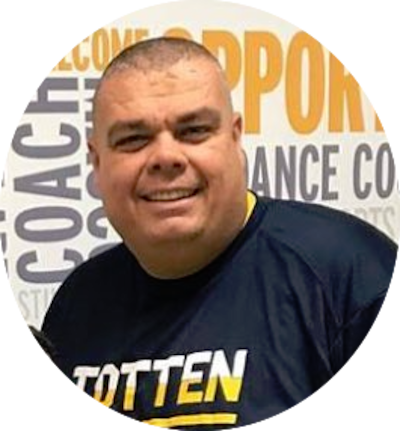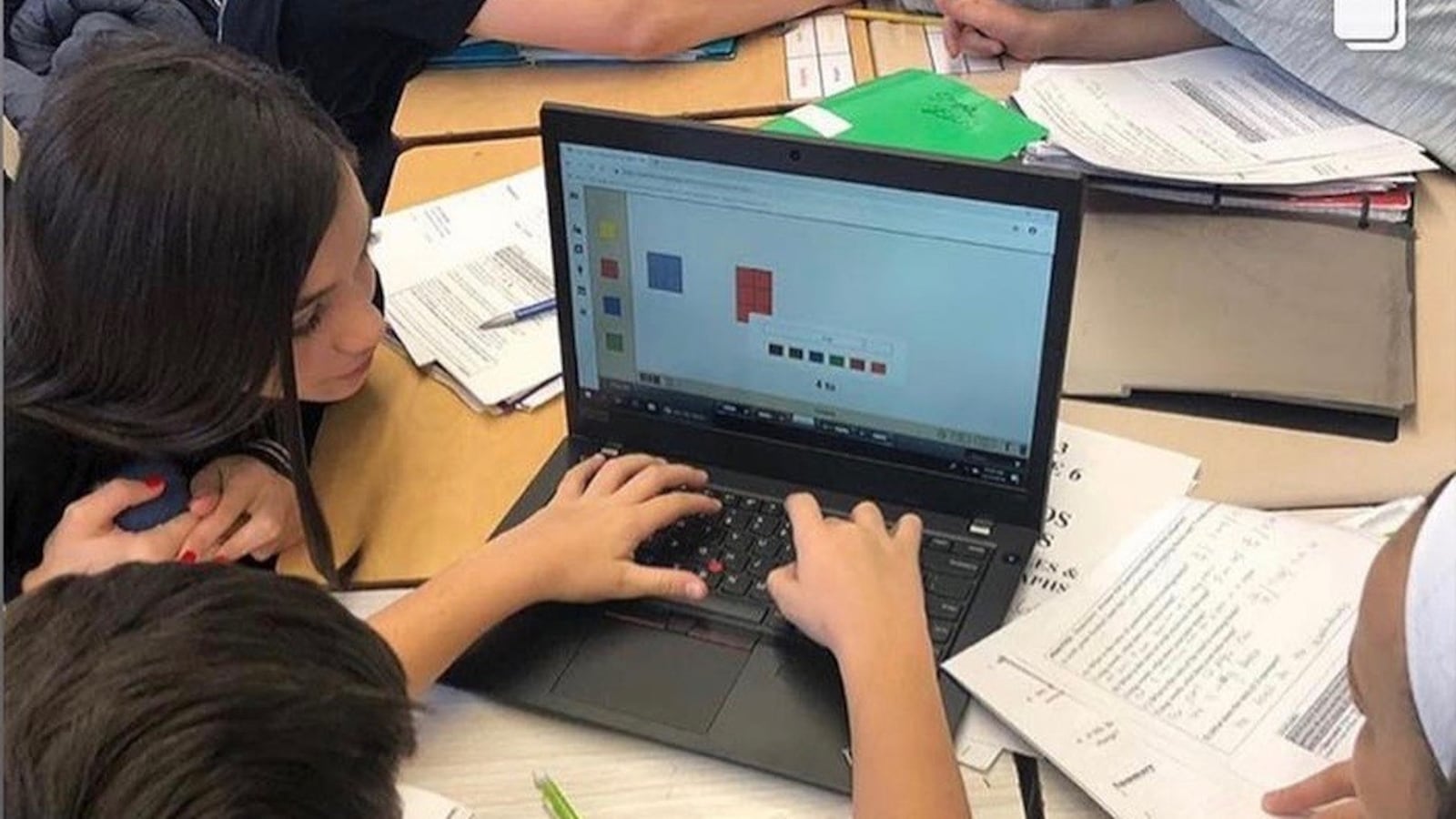John Boyle knows how to lead a school through tragedy — but he also knows how to throw a good party.
He was the principal of I.S. 34 Totten Intermediate on Staten Island when Hurricane Sandy plowed through the city, claiming the life of one of his students. On the day of her funeral, the school put a call out to classmates to line the streets in support, wearing the school’s color, purple.
When another student was unable to attend her eighth grade prom because of a cancer diagnosis, the school brought a party to her backyard, complete with a dance floor, photographer, and food.
“If it was your son or your daughter, what would you want?” he asked. “We try to give the best that we can give.”

Boyle was recently recognized by the Council for School Supervisors and Administrators, whose president gave Boyle a nod in a speech at the union’s annual conference.
A 19-year veteran of the city’s school system, Boyle has spent his career working with middle schoolers, who he thinks get a bad rap. (The previous Chancellor often said seventh graders were a particularly tough bunch to teach.)
“I think it does take a special person to work in middle school, and I think it’s just about developing relationships with kids this age. They love interactions with positive people,” he said. “Don’t just say: ‘They’re older. They’re on their own now.’”
The school is known for keeping parents informed on its social media channels and frequently updated website, which has earned around a million views, Boyle said. In a city that offers plenty of school choice, I.S. 34 is a zoned school, enrolling generations of Staten Islanders, one family member after another. But with an eye towards equity and diversity, Boyle says the school is hoping to open its doors to more students.
Here’s what Boyle had to say about how he became an educator, why he likes to visit each floor of his school building daily, and how to develop a school brand.
Responses have been edited for length and clarity.
What sparked your interest in schools and what was your first job in education?
I entered college as a business major. I always thought I would trek into Manhattan on the ferry each day. Each summer all through college, I worked as a coach and counselor at Monsignor Farrell basketball camp. Most of the counselors were teachers, coaches, and administrators. They all had such passion for their careers. That was missing for me; I had no passion for business. After my first summer, I realized that I had caught the coaching bug, and teaching was a perfect avenue to pursue. I changed my major to education and never looked back! It was one of the best moves I’ve ever made.
Fill in the blank. My day at school isn’t complete unless I ___________. Why?
Make my way to each of our schools’ four floors. It is almost impossible to be in each classroom each day, but my team and I try to interact with students and staff as much as possible. It’s the personal connections that matter most in education. Everyone has a story, and you are never going to hear it sitting in your office. I believe in always being a visible presence in our school. Walking the halls, stopping in two or three classrooms, popping into lunch periods, dropping by a common planning period, sitting in on a parent conference, observing an amazing lesson, checking in with our school safety agents, having a cup of coffee with my assistant principals are all part of my daily routine. At I.S. 34 we say that every day is #JustAnotherGreatDayAtIS34, and traveling through the building each day allows me to keep my finger on the pulse of our school.
What is the hardest part of your job?
The hardest part of my job is trying to figure out how we can support “one of our own” during a time of need or during a crisis. During my seven years as principal of I.S. 34, we have had students and staff stricken with illness and disease, students lose parents and loved ones, students and staff lose their homes to fire and floods and worst of all, a student losing her life during Superstorm Sandy. As principals we are used to people looking to us for answers and solutions, and we are almost always able to help. One of the things that sets our school apart is that we always take care of our own.
What is an effort you’ve spearheaded at your school that you’re particularly proud of?
Last school year, one of our eighth grade students was diagnosed with stage-four Ewing’s Sarcoma. Due to her weakened immune system, she was unable to return to school. Through our best efforts, we tried to include her in all of our eighth grade events. Her one goal was to become healthy enough to attend our eighth grade prom. As we got closer to the date it became clear that attending prom wasn’t a viable option. So we decided to bring the prom to her.
We immediately received an outpouring of generous donations. A delicious custom cake was donated by a local bakery. A DJ company supplied music and a dance floor. A staff member provided a candy table and custom party favors. A local spa provided a day of beauty and makeup. A local restaurant catered the entire event, a local photographer provided photos, and our yearbook vendor supplied a videographer. Our local police precinct provided security, our school bus vendor offered transportation, and our custodial staff provided setup and cleanup for the entire event. We also held a fun-run fundraiser for a custom prom dress and a beautiful wig. The eighth grade student being honored danced and partied alongside her closest friends. It was an amazing event and a total team effort.
Tell us about a memorable time — good or bad — when contact with a student’s family changed your perspective or approach.
About seven years ago I met a young man, who has since developed into one of my heroes and friends. In fourth grade, he went by J. H. Both his brother and sister attended I. S. 34, and J.H. and his family live directly across the street from the school. J.H. is often wheelchair-bound, having been born with Epidermolysis Bullosa. J.H. dreamed of attending I.S. 34 but feared he would be unable to do so because the school was not accessible to wheelchairs. When I first met J.H., he asked me if we could build an elevator at I.S. 34. I promised him that we would try. But quite honestly, I didn’t think it would ever happen.
About a year later, J.H. was ready to graduate from elementary school. But we still weren’t barrier-free. We reprogrammed the entire school to allow J.H. to attend all of his classes on the first floor of his neighborhood school. But he and his family and friends never gave up the fight. One day he convinced Kathleen Grimm, who was then deputy chancellor, to allocate funding for a multi-million-dollar full-accessibility project. Upon completion, our school will be fully compliant with the Americans with Disabilities Act and accessible to anyone. The elevators were not built in time for J.H. to ride them as a student. But he has promised to join me for the inaugural ride as a proud alumni and member of the Class of 2016. J.H. taught me that anything is possible if you never give up.
What issue in the education policy realm is having a big impact on your school right now? And how are you addressing it?
School branding is a relatively recent trend that is emerging in schools throughout the country to create purpose and cohesion. I think that our school has been a standard-bearer for the branding movement in our district. Each day I try and capture the amazing things happening in our school and memorialize them on social media. I believe in celebrating student accomplishments. Capturing these moments allows our parents an opportunity catch a glimpse of their child’s day-to-day experience. At our school we say that every day is #JustAnotherGreatDayAtIS34. That hashtag is mounted above our main entrance and is the message I want to convey. We work tirelessly to ensure that our hashtag is a core belief that is ingrained in our daily routines.
What’s the best advice you ever received?
About nine years ago, after being an assistant principal for a long time, I began to realize that I wanted to take the next step and become a principal. I was applying and being considered for a few different principal positions in various parts of the city. None of those opportunities felt right to me. I ended up having a conversation with a man whom I respect very much, and he told me, “Don’t rush into this. You will know when the right spot becomes available.” This advice gave me the confidence to hit pause on my quest. Shortly thereafter, one of my mentors announced his retirement. He was the principal at I.S. 34, and I was his AP for six years. I knew I was in the “right spot!” I applied for the position, and the rest is history.


